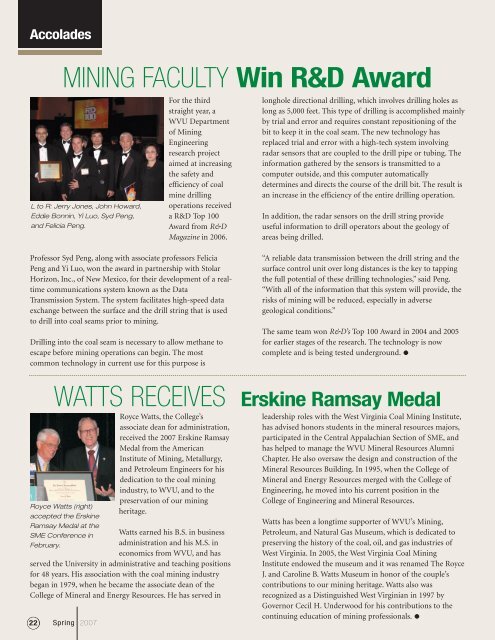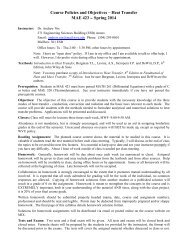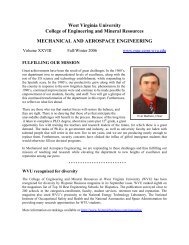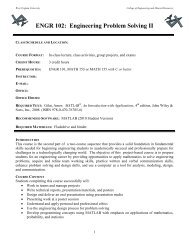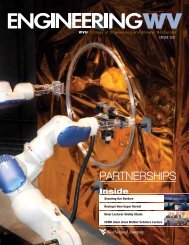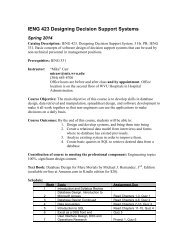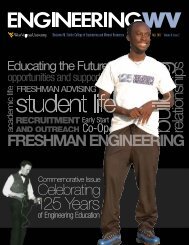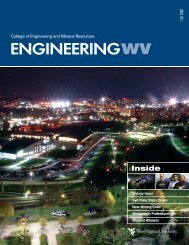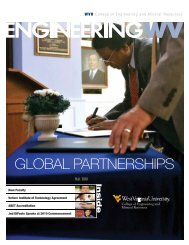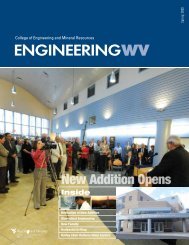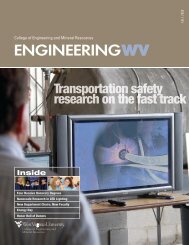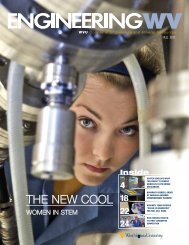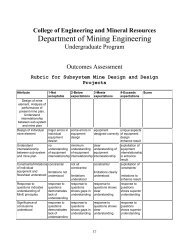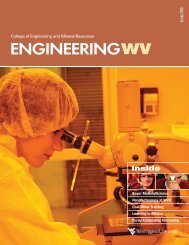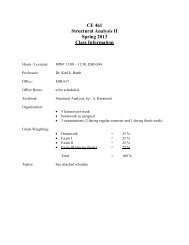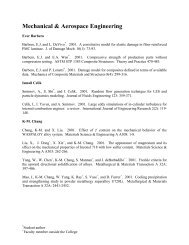70931, page 1-35 @ Normalize - WVU College of Engineering and ...
70931, page 1-35 @ Normalize - WVU College of Engineering and ...
70931, page 1-35 @ Normalize - WVU College of Engineering and ...
Create successful ePaper yourself
Turn your PDF publications into a flip-book with our unique Google optimized e-Paper software.
Accolades<br />
MINING FACULTY Win R&D Award<br />
L to R: Jerry Jones, John Howard,<br />
Eddie Bonnin, Yi Luo, Syd Peng,<br />
<strong>and</strong> Felicia Peng.<br />
For the third<br />
straight year, a<br />
<strong>WVU</strong> Department<br />
<strong>of</strong> Mining<br />
<strong>Engineering</strong><br />
research project<br />
aimed at increasing<br />
the safety <strong>and</strong><br />
efficiency <strong>of</strong> coal<br />
mine drilling<br />
operations received<br />
a R&D Top 100<br />
Award from R&D<br />
Magazine in 2006.<br />
longhole directional drilling, which involves drilling holes as<br />
long as 5,000 feet. This type <strong>of</strong> drilling is accomplished mainly<br />
by trial <strong>and</strong> error <strong>and</strong> requires constant repositioning <strong>of</strong> the<br />
bit to keep it in the coal seam. The new technology has<br />
replaced trial <strong>and</strong> error with a high-tech system involving<br />
radar sensors that are coupled to the drill pipe or tubing. The<br />
information gathered by the sensors is transmitted to a<br />
computer outside, <strong>and</strong> this computer automatically<br />
determines <strong>and</strong> directs the course <strong>of</strong> the drill bit. The result is<br />
an increase in the efficiency <strong>of</strong> the entire drilling operation.<br />
In addition, the radar sensors on the drill string provide<br />
useful information to drill operators about the geology <strong>of</strong><br />
areas being drilled.<br />
Pr<strong>of</strong>essor Syd Peng, along with associate pr<strong>of</strong>essors Felicia<br />
Peng <strong>and</strong> Yi Luo, won the award in partnership with Stolar<br />
Horizon, Inc., <strong>of</strong> New Mexico, for their development <strong>of</strong> a realtime<br />
communications system known as the Data<br />
Transmission System. The system facilitates high-speed data<br />
exchange between the surface <strong>and</strong> the drill string that is used<br />
to drill into coal seams prior to mining.<br />
Drilling into the coal seam is necessary to allow methane to<br />
escape before mining operations can begin. The most<br />
common technology in current use for this purpose is<br />
“A reliable data transmission between the drill string <strong>and</strong> the<br />
surface control unit over long distances is the key to tapping<br />
the full potential <strong>of</strong> these drilling technologies,” said Peng.<br />
“With all <strong>of</strong> the information that this system will provide, the<br />
risks <strong>of</strong> mining will be reduced, especially in adverse<br />
geological conditions.”<br />
The same team won R&D’s Top 100 Award in 2004 <strong>and</strong> 2005<br />
for earlier stages <strong>of</strong> the research. The technology is now<br />
complete <strong>and</strong> is being tested underground.<br />
22<br />
WATTS RECEIVES Erskine Ramsay Medal<br />
Royce Watts (right)<br />
accepted the Erskine<br />
Spring 2007<br />
Royce Watts, the <strong>College</strong>’s<br />
associate dean for administration,<br />
received the 2007 Erskine Ramsay<br />
Medal from the American<br />
Institute <strong>of</strong> Mining, Metallurgy,<br />
<strong>and</strong> Petroleum Engineers for his<br />
dedication to the coal mining<br />
industry, to <strong>WVU</strong>, <strong>and</strong> to the<br />
preservation <strong>of</strong> our mining<br />
heritage.<br />
Ramsay Medal at the<br />
SME Conference in Watts earned his B.S. in business<br />
February.<br />
administration <strong>and</strong> his M.S. in<br />
economics from <strong>WVU</strong>, <strong>and</strong> has<br />
served the University in administrative <strong>and</strong> teaching positions<br />
for 48 years. His association with the coal mining industry<br />
began in 1979, when he became the associate dean <strong>of</strong> the<br />
<strong>College</strong> <strong>of</strong> Mineral <strong>and</strong> Energy Resources. He has served in<br />
leadership roles with the West Virginia Coal Mining Institute,<br />
has advised honors students in the mineral resources majors,<br />
participated in the Central Appalachian Section <strong>of</strong> SME, <strong>and</strong><br />
has helped to manage the <strong>WVU</strong> Mineral Resources Alumni<br />
Chapter. He also oversaw the design <strong>and</strong> construction <strong>of</strong> the<br />
Mineral Resources Building. In 1995, when the <strong>College</strong> <strong>of</strong><br />
Mineral <strong>and</strong> Energy Resources merged with the <strong>College</strong> <strong>of</strong><br />
<strong>Engineering</strong>, he moved into his current position in the<br />
<strong>College</strong> <strong>of</strong> <strong>Engineering</strong> <strong>and</strong> Mineral Resources.<br />
Watts has been a longtime supporter <strong>of</strong> <strong>WVU</strong>’s Mining,<br />
Petroleum, <strong>and</strong> Natural Gas Museum, which is dedicated to<br />
preserving the history <strong>of</strong> the coal, oil, <strong>and</strong> gas industries <strong>of</strong><br />
West Virginia. In 2005, the West Virginia Coal Mining<br />
Institute endowed the museum <strong>and</strong> it was renamed The Royce<br />
J. <strong>and</strong> Caroline B. Watts Museum in honor <strong>of</strong> the couple’s<br />
contributions to our mining heritage. Watts also was<br />
recognized as a Distinguished West Virginian in 1997 by<br />
Governor Cecil H. Underwood for his contributions to the<br />
continuing education <strong>of</strong> mining pr<strong>of</strong>essionals.


